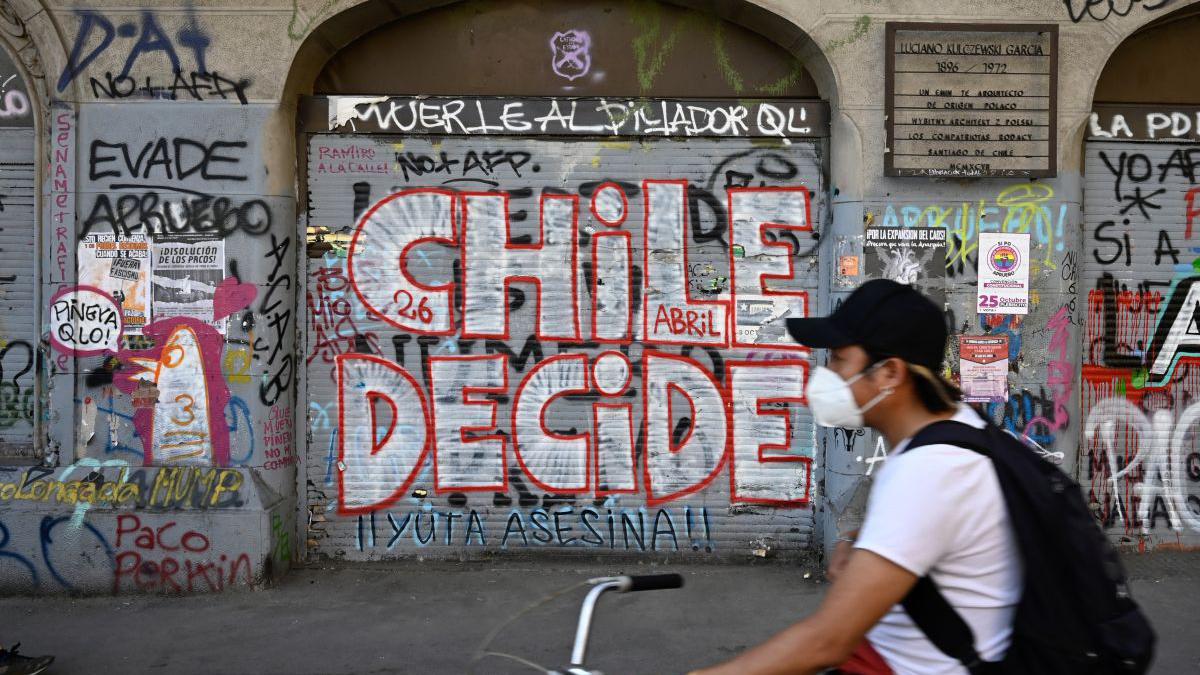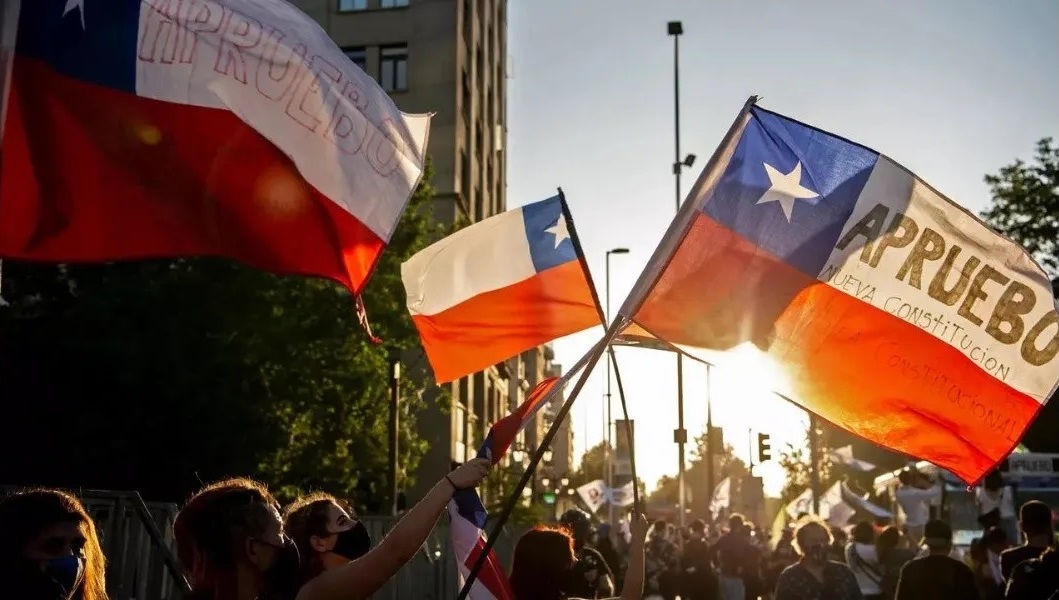RIO DE JANEIRO, BRAZIL – Chilean streets filled for the first time since the coronavirus outbreak on Sunday, October 25th, as millions of people turned out to vote on whether to tear up its Pinochet-era constitution in favour of a fresh charter drafted by citizens.
The La Moneda government palace is surrounded by metal bars. Stores, closed by quarantine or bankrupt and with “for sale” signs, have their metal shutters down.
On them, on the walls and bus stops in downtown Santiago, one can read: “I approve”, “freedom to political prisoners”, “for our pensioners”, “New constitution is communism”, “São Paulo Forum Out”.
Around Plaza Italia, recently renamed Plaza Dignitaria, police officers guard the statue of General Baquedano. There, for over a year now, demonstrators have been gathering to start a protest that has left 30 dead and forced the government to determine that a referendum be held on Sunday, October 25th, despite the coronavirus pandemic.

The referendum has two questions. The first is “do you approve a new Constitution?” to which the Chilean must answer “I approve” or “I don’t approve”; the second is “which body should write it?” for which the options are the election of a Constituent Assembly or the creation of a mixed constitutional convention, composed of already elected legislators and constituents, to be elected by voters.
“I will vote ‘I approve’ because the state needs to be more present. This idea that the market and the people take care of themselves no longer applies. With a pandemic? In a world with less and less work?” says Pablo Morón, 24, an unemployed IT graduate. “We need a modern State that keeps up with the transformations in the world of labor, that empowers young people for free and that protects our health.”
Micaela Aránguez, 48, a bank employee, thinks differently and will vote “I don’t approve’. In her opinion, Congress is already funded by the taxpayer and electing more people will only create more costs for Chileans.
“All this for a long, expensive process, while we are facing much more pressing problems. This is not the time for the country to be making this effort”. Aránguez also argues that it would be easier to just change laws that, she believes, are not working, “like the Welfare one,” because changing the entire Constitution would open “room for communists to introduce other unnecessary items.”
A few blocks away from Plaza Italia, a group of girls chatted. In an example of how diffuse the interests are and how the demonstrations began from the increase in the subway fare to include all inequalities in the country, Ana Parraguirre, 22, argues that she will vote “I approve” so that the new Charter will “value women adequately”. “We want an abortion law, we want a guarantee of equal pay.”
Although the voting intention polls give a wide lead to “I approve”, with 69 percent of projected votes, against 18 percent for “I don’t approve”, according to Data Influye, the climate in Santiago is not one of celebration.
On October 18th, when activists were celebrating the one-year anniversary of the protests, two churches were burned down and there were lootings of stores and supermarkets. If the pandemic had reduced the intensity of protests for a while, in the past few months the demonstrations have gained momentum again, with the addition of the economic crisis caused by the quarantine measures.
“There is a risk that even the approval will not be enough to calm the spirits. Demonstrators want more. They know that the process is long, that it doesn’t solve urgent problems, and they don’t want traditional politicians leading the way. Politics is discredited,” says political scientist Marco Moreno.
“Whoever is elected to this Assembly will have to live up to what the demonstrators want, and it is difficult for that to be the case, so I believe that people will remain on the streets”.
The current Chilean Constitution was enacted in 1980, during the military dictatorship (1973-1990). Replacing it entirely would be an important symbol for demonstrators.
For political analyst Patricio Navia, the fact that the Charter dates back to the time of Augusto Pinochet, whose regime was marked by torture, deaths, and human rights violations, is a blemish for the country, but he recalls that the document has already been reformed and that “its most authoritarian tones have been removed.”
“There are people defending it just because it bears the Pinochet mark.”
Those who criticize specific motives in the current Constitution denounce the document’s emphasis on a free market and the few devices to protect workers. The Charter is also limited in relation to guarantees that the state must offer health and education to the population.
During her two terms of office, former center-left President Michelle Bachelet changed the section on education, for instance. Through amendments, she succeeded in ensuring that 40 percent of the poorest students did not pay for university. Earlier, everyone had to pay. Still, many still fight for fully free public education system.
But the critical point in the debate is Social Welfare. Chile has an individual capitalization system, in which workers contribute ten percent of their salaries to their own pensions, with little or no state contribution in the case of the poorest sectors of society.
Those in favor of changing the Constitution want a more robust retirement system guaranteed by law. The country’s pensioners receive, on average, between 30 and 40 percent of their last salary in active employment, about US$400 (R$2.247). The amount is below the Chilean minimum wage.
There are also other issues that protesters want to see printed in the new text: gender equity, universal and free medical assistance, greater participation of indigenous peoples (13 percent of the population) in political decisions, and free public transportation, for instance.
President Sebastián Piñera said he hopes that this Sunday’s election will be held peacefully and that Chileans will express their discontent through democratic means. If “I approve” should win, elections are scheduled for April 2021.

Understand the plebiscite. What will be voted?
The Chilean population will decide if the country will pass or reject the drawing up of a new Constitution, in a vote on Sunday, October 25th.
The plebiscite will also ask whether the new Charter, if approved, should be drafted by a constituent assembly made up only of representatives elected for that specific purpose, or by a joint assembly half of whose members are now in Congress.
What are the criticisms of the current Constitution?
Liberal, the Charter does not mandate the state to directly provide health, education, and social protection to Chileans, which encourages private action in these areas. A constitutional change could force the government to be more active and expand the population’s access to basic services.
Another criticism is that it was introduced by Augusto Pinochet’s dictatorship in 1980, with little popular involvement, and that rebuilding it will allow demands from more groups, particularly women, to be included.
And what are the reasons for not changing it?
‘No’ advocates say that a radical change could compromise economic stability and argue that the Constitution should only be reformed.
Critics of the change point out that expanding the government’s social performance hinges much more on having money in hand than on the Constitution’s intentions, and consider that it should not be as detailed as pointing out which social issues the government should act on.
How did the plebiscite come about?
The change in the Constitution was among the demands of the protests held in the country since October 2019. The trigger was the rise of the subway fare in Santiago, but it soon became a movement against the rising living costs, the difficulty in accessing education and health, and the low pensions.
Congress passed a constitutional plebiscite in November, to be voted on in April. Because of the pandemic, it was deferred to October.
Chronology of the crisis in Chile
October 19th, 2019
A protest against the rise in the subway fare in Santiago is the catalyst for a wave of demonstrations across the country against social inequality and the high living costs. The protests last for weeks and attract thousands of people. There were lootings and clashes with the police.
November 19th
In reaction to the demonstrations, Congress passed a plebiscite to draw up a new Constitution. The vote was scheduled for April but was then deferred because of the pandemic.
December 19th
The government makes concessions, such as raising the minimum retirement amount as well as a bonus for poor families.
January 20th, 2020
At the end of the month, protests gather momentum again and register violence. Protests and clashes continue throughout February.
March 20th
The country enters a state of disaster because of the pandemic, and social isolation prevents protests.
October 18th – 20th
After the removal of social isolation measures, Chile again sees street protests. On October 18th, there are clashes and two churches are burned down.
Source: Folhapress

